
Dorothea Lynde Dix was an American advocate on behalf of the indigent mentally ill who, through a vigorous and sustained program of lobbying state legislatures and the United States Congress, created the first generation of American mental asylums. During the Civil War, she served as a Superintendent of Army Nurses.

Mary Ann Bickerdyke, also known as Mother Bickerdyke, was a hospital administrator for Union soldiers during the American Civil War and a lifelong advocate for veterans. She was responsible for establishing 300 field hospitals during the war and served as a lawyer assisting veterans and their families with obtaining pensions after the war.

Mary Livermore was an American journalist, abolitionist, and advocate of women's rights. Her printed volumes included: Thirty Years Too Late, first published in 1847 as a prize temperance tale, and republished in 1878; Pen Pictures; or, Sketches from Domestic Life; What Shall We Do with Our Daughters? Superfluous Women, and Other Lectures; and My Story of the War. A Woman's Narrative of Four Years' Personal Experience as Nurse in the Union Army, and in Relief Work at Home, in Hospitals, Camps and at the Front during the War of the Rebellion. She wrote a sketch of the sculptor Anne Whitney for Women of the Day and delivered the historical address for the Centennial Celebration of the First Settlement of the Northwestern States in Marietta, Ohio on July 15, 1788.

Cornelia Hancock was a celebrated volunteer nurse, serving the injured and infirmed of the Union Army during the American Civil War. Hancock's service lasted from July 6, 1863 to May 23, 1865.

The United States Sanitary Commission (USSC) was a private relief agency created by federal legislation on June 18, 1861, to support sick and wounded soldiers of the United States Army during the American Civil War. It operated across the North, raised an estimated $25 million in Civil War era revenue and in-kind contributions to support the cause, and enlisted thousands of volunteers. The president was Henry Whitney Bellows, and Frederick Law Olmsted acted as executive secretary. It was modeled on the British Sanitary Commission, set up during the Crimean War (1853-1856), and from the British parliamentary report published after the Indian Rebellion of 1857.

Satterlee General Hospital was the largest Union Army hospital during the American Civil War. Operating from 1862 to 1865 in Philadelphia, Pennsylvania, its physicians and nurses rendered care to thousands of Union soldiers and Confederate prisoners. After its patient population spiked following the battles of Bull Run and Gettysburg, this hospital became the second-largest in the country with 34 wards and hundreds of tents containing 4,500 beds.
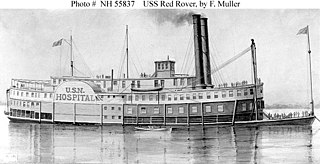
USS Red Rover was a 650-ton Confederate States of America steamer that the United States Navy captured. After refitting the vessel, the Union used it as a hospital ship during the American Civil War.

The Commonwealth of Massachusetts played a significant role in national events prior to and during the American Civil War (1861–1865). Massachusetts dominated the early antislavery movement during the 1830s, motivating activists across the nation. This, in turn, increased sectionalism in the North and South, one of the factors that led to the war. Politicians from Massachusetts, echoing the views of social activists, further increased national tensions. The state was dominated by the Republican Party and was also home to many Radical Republican leaders who promoted harsh treatment of slave owners and, later, the former civilian leaders of the Confederate States of America and the military officers in the Confederate States Army.
Eliza Newton Woolsey Howland was an American author and the wife of Union Army officer Joseph Howland.

The New England state of Connecticut played an important role in the American Civil War, providing arms, equipment, technology, funds, supplies, and soldiers for the Union Army and the Union Navy. Several Connecticut politicians played significant roles in the Federal government and helped shape its policies during the war and the Reconstruction.
During the American Civil War, sexual behavior, gender roles, and attitudes were affected by the conflict, especially by the absence of menfolk at home and the emergence of new roles for women such as nursing. The advent of photography and easier media distribution, for example, allowed for greater access to sexual material for the common soldier.

The state of medical knowledge at the time of the Civil War was extremely primitive. Doctors did not understand infection, and did little to prevent it. It was a time before antiseptics, and a time when there was no attempt to maintain sterility during surgery. No antibiotics were available, and minor wounds could easily become infected, and hence fatal. While the typical soldier was at risk of being hit by rifle or artillery fire, he faced an even greater risk of dying from disease.

Camp Letterman was an American Civil War military hospital, which was erected near the Gettysburg Battlefield to treat more than 14,000 Union and 6,800 Confederate wounded of the Battle of Gettysburg at the beginning of July, 1863.
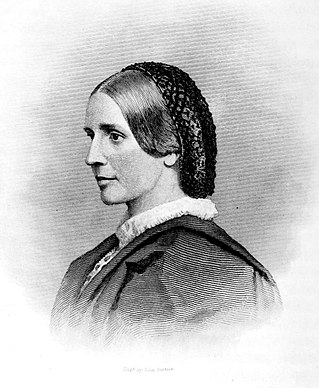
Emily Elizabeth Parsons was an American Civil War nurse, hospital administrator, and founder of Mount Auburn Hospital in Massachusetts. Her posthumous memoir, Fearless Purpose: Memoir of Emily Elizabeth Parsons, gives a rare glimpse of the American Civil War from a nurse's perspective as she describes her work tending to Union soldiers and managing the nursing staff at Benton Barracks Hospital in St. Louis, Missouri.
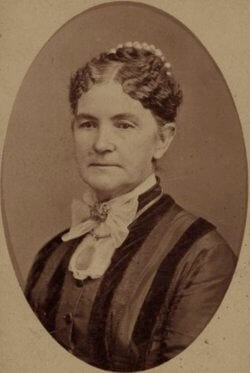
Adaline Weston Couzins was a British-born American civil servant, a suffragist, and a Civil War nurse who worked for the Ladies' Union Aid Society of St. Louis. She spent most of her career as a nurse during the Civil War on hospital ships that tended to Union and Confederate soldiers all along the Mississippi River.
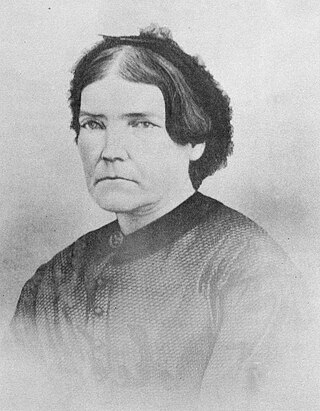
Elizabeth "Eliza" George, nicknamed "Mother George" by the Union army soldiers under her care, served the final two-and-a-half years of her life as a volunteer nurse in the South during the American Civil War. Initially discouraged from serving because of her age and the harsh conditions of wartime service, the fifty-four-year-old widow left her Fort Wayne, Indiana, home in February 1863 and died in May 1865 of typhoid fever, which she contracted while nursing soldiers and civilians at Wilmington, North Carolina, a month after the end of the war. George was buried with full military honors at Lindenwood Cemetery in Fort Wayne, Indiana; a monument erected near her gravesite pays tribute to her wartime service.
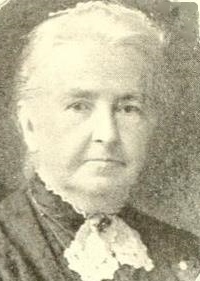
Clarissa Fellows Jones Dye, served as an Army nurse during the American Civil War. Later in life, she was president of the National Association of Army Nurses of the Civil War.

Elizabeth "Eliza" Harris served as a United States Sanitary Commission agent, army nurse, and newspaper correspondent during the American Civil War. She was active in the Eastern Theater of the American Civil War until September 1863, when she went to Tennessee for several months before returning to the east. After the war, she was active in national reform causes.

Maria M. C. Hall was an American Civil War nurse.

Abby Howland Woolsey was an American social worker and nursing educator.

















